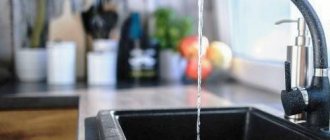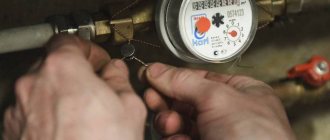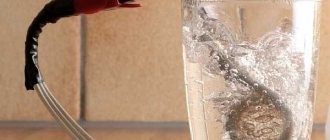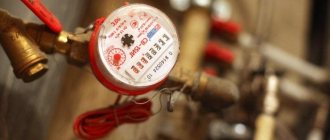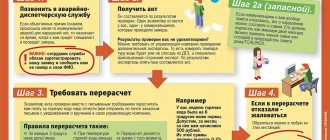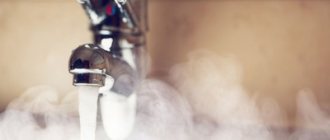The difference in using hot water between a country house and an apartment mainly lies in the fact that in an individual autonomous heating system you can always control and adjust the temperature and pressure of the coolant flowing through the pipes, but in a centralized heating system these parameters are set in the boiler room, and the owner of the apartment does not cannot affect the adjustment of the characteristics of the working fluid. But what the hot water temperature should be can be controlled in the apartment. This must be done at least to ensure that the temperature of the hot water supply and heating complies with the standards and ensures comfortable living and use of hot water in the bathroom, kitchen and other water points. Therefore, if during the year, instead of hot water of a certain temperature, you receive barely warm or even cold water, then you should think about how and where to write an application in order to achieve the targeted spending of your utility bills.
Standard DHW temperature
How the temperature range is set
Information about what temperature hot water should be in the water supply and central heating is set out in SanPiN 2.1.4.2496-09 (sanitary rules and regulations that determine the temperature of hot water supply and heating) and GOST R 51617-2000 (air temperature in the room when using heating and DHW). The parameters do not change for a long time, as they are determined by the appropriateness of these values - a person should feel comfortable and not experience any inconvenience when using hot water in one form or another.
Since the temperature of the water in the hot water supply depends on the technical solution for the water supply of the house or apartment, the temperature for the hot water supply and hot water supply routes will always be different. The temperature in the DHW system should not go beyond 600C-750C for all water points. If the DHW circuit is a closed type, then the minimum permissible water temperature should be 500C, for an open DHW it is 600C.
Housing and communal services standards contain the following permissible deviations: a decrease in temperature by 50C at night (from 0.00 to 5.00) and a decrease in temperature during the day by 30C (from 5.00 to 0.00). These rules are based not only on the comfort of using hot water, but also on the safety of residents. If the deviation from the regulations exceeds the specified limits for every 30C, residents have the right to demand that the payment for hot water supply be reduced by 0.1% for every 60 minutes of violation. If during control temperature measurements the thermometer showed a temperature of ≤ 400C, then payment for utilities is carried out according to the tariffs for cold water supply. To confirm the data, it is necessary to carry out an official measurement and draw up a report certifying the deviation from the SanPiN regulations.
If the water in the pipes is hot, it can cause burns, especially to children. In addition, modern pipe lines are made of plastic or metal-plastic, and high water temperatures have a destructive effect on them. When the temperature in the pipes exceeds 760C, a violation of the regulations occurs, just as when the temperature decreases to 560C, and residents have the right to write an individual or collective complaint against the utility company.
Normal temperature range
There is also another rule that forces you to regulate the hot water supply in the apartment within 60-750C. In warm water, microorganisms and pathogenic bacteria begin to multiply quickly and actively. Therefore, the temperature limit must cover the values. In which a person will not receive burns, but microorganisms will die without causing harm to consumers. This rule is especially relevant for children's and medical institutions.
Legionella, a bacterium that causes pneumonia of unknown etiology, multiplies well in warm fresh water. This means that in most cases the disease is not identified or is identified incorrectly, which leads to incorrect treatment with corresponding results, including death. But in hot water, Legionella dies depending on the temperature:
- At 70−800C, the water is completely disinfected - all bacteria die instantly;
- At 660C, legionella dies in 120 seconds;
- At a temperature of 600C, microorganisms die in 22 minutes;
- At 550C, bacteria die in 6-7 hours;
- At a temperature of 20−45°C, the active phase of legionella reproduction begins;
- At temperatures ≤ 20°C, Legionella cannot reproduce due to the cold.
Temperature graph of Legionella reproduction
Based on the above, it becomes clear that at high temperatures, the use of hot water is safe in terms of morbidity, but unsafe in terms of possible burns:
- When the water temperature in the hot water supply is ≤ 500C, there is a sufficient degree of risk of getting a burn;
- At temperatures ≥ 650C, skin burns occur within 2-5 seconds;
- At a water temperature of 55 °C, a burn can occur in one and a half minutes.
The problem is solved as follows: when hot water is centrally distributed to residential buildings, it is first stored in tanks where a temperature sufficient to kill bacteria is maintained. As hot water supply is supplied to the house, its temperature drops to a regulated level, and the use of hot water should be carried out only with the simultaneous connection of cold water supply to the house.
Burns depending on the water temperature in the DHW system
How to measure hot water supply according to the law
If residents suspect that the hot water in the system is not at the proper level, it is necessary to demand that the resource supply organization correct this discrepancy.
But first you need to prove this, for which you measure the temperature of the hot water supply, and in several places, in order to find out the root of the problem. Residents can do this themselves, but their result will not have legal force. However, it will show that there really are reasons to be dissatisfied with the quality of services.
To do this, you need to follow the algorithm of actions:
- Open the DHW mixer and wait until it gets as hot as possible.
- Pour at least 1 liter of water into a container that holds heat well and keep it under an open tap so that the water flows out.
- Lower the water thermometer.
- Record the readings.
If the water is really colder than the set level, you can take the next step - call the emergency dispatch service of the Criminal Code or RSO. Their responsibilities are divided: management companies are responsible for the maintenance of common building communications, and resource supply organizations are responsible for supplying water of the required temperature to the system.
The utility dispatcher must register the call and send a specialist who will draw up a report. Within two hours, the violation must be identified and activated. The document is drawn up in several copies, one for each party.
At the entrance to an apartment building
At the entrance to the apartment building, the temperature is measured to understand what resource the RSO centrally supplies to the house. If it does not meet the standard, it means that the boiler room does not provide sufficient heating.
The specialist uses professional techniques and instruments; it is not possible to take measurements on your own. If the result is positive and water enters the house of proper quality, RSO is not to blame. The area of responsibility of the management company begins.
In a pipe system
Only a management company employee can measure the temperature in the pipe system. This requires certain knowledge of the technique and special equipment. The work is most often carried out in the basement, from where the pipeline is routed to the apartments.
In the apartment
According to Government Decree No. 354, the consumer must drain the water for no more than 3 minutes before measuring the temperature. This requirement provides the most objective indicators. Therefore, during the experiment, the owner must be present and closely monitor the actions of the management company employee.
You also need to pay attention to the devices used: they must be certified and verified, and not subject to external heating. The thermometer must be kept in the water for a sufficient amount of time.
Based on the results of the measurements, the management company employee will draw up a report in 2 copies, in which the consumer will sign.
The reasons may be:
- the heating supply organization does not heat the water to the established temperature conditions;
- design flaws in the installation of a hot water supply system.
- the pipe is clogged;
- improperly installed devices in the path of water.
- the residential building was the last one on the supply line; its pipeline was not looped.
ADVICE! If the consumer is dissatisfied with the result of the measurements of the management specialist, he has the right to order an independent examination. It will be carried out at the expense of the Criminal Code if its accusations are confirmed. If not, the cost will have to be reimbursed to the customer.
Water quality in hot water supply
What is regulated by Snip, GOST and SanPin ? SanPiN Resolution 2.1.4.2496-09, clause 2.4 regulates the temperature standards for transporting water to residential buildings, and the maximum temperature limits for hot water in an apartment are 600C to 750C. In addition, hot water in the apartment should not have any foreign odors or taste impurities. If for some reason the temperature regulations are not observed, a complaint can be filed against organizations involved in the delivery of hot water to residential buildings in order to eliminate the cause of the violation of GOST. In each region, the application form will be original, so here are a few examples of such applications:
Statement of violation of hot water standards
https://youtu.be/1viQbRTzQ6A
Arbitrage practice
Non-compliance of hot water temperature with accepted standards can cause moral harm and cause physical and moral suffering to consumers. During the proceedings, the court forces the company providing the poor-quality service to compensate for the inconvenience caused. This situation was considered in case No. 2 - 974/10. The plaintiffs were citizen D. and her young son. They accused the management company of providing hot water that did not meet SanPiN temperature standards. To bathe her minor son, citizen D. had to heat the water manually. This went on for several years. The management company’s employees did not react in any way to the plaintiffs’ claims and did not take any measures to correct the problems.
In the statement of claim, D. demanded that the defendant recalculate the payment for hot water supply, eliminate violations and pay moral damages in favor of each plaintiff in the amount of 10 thousand rubles. During the consideration of the case, the court relied on Art. No. 161, 162 of the Housing Code of the Russian Federation, according to which the management company is obliged to provide citizens living in an apartment building with favorable conditions. Also, the management company must consider all complaints and appeals from consumers. The company evaded compliance with the obligations specified in the service agreement. As a result of the trial, the court decided to satisfy the claim for compensation for moral damage, recalculate and eliminate all problems associated with providing residents with hot water.
How to measure temperature
To find out what hot water temperature is normal or not, first independent measurements are taken, and only after this it is necessary to invite official representatives of utility services to carry out official measurements and draw up relevant supporting documents.
To measure the temperature of hot water yourself, open any hot water tap and drain the water for 180 seconds, then fill any container with water (for example, a liter jar) and measure the temperature with a regular household thermometer. To do this, lower it into the jar for a few minutes and wait until the thermometer readings stop changing. If the thermometer shows too low or too high values, contact the utility companies with appropriate statements. If for some reason it is impossible to make a written application, then the dispatcher is obliged to accept an oral telephone complaint or an application for a control measurement by official representatives of the company. If the violation is eliminated without control measurements, the dispatcher is obliged to inform the applicant about this.
If the reason why the temperature schedule is violated is unknown, then a representative of the utility organization is obliged to arrive at the applicant for an official no later than 120 minutes after receiving any application - oral or written. Other time intervals are discussed with the applicant.
Repeated measurements of the DHW temperature are made by an official, after which a report on measuring the water temperature must be drawn up, and on the basis of this document, in the event of an obvious violation, the payment for DHW must be recalculated at other tariffs. The act is drawn up in two copies, one copy is sent to the management company, the second must be with the owner of the property.
DHW control measurement report
Control by measurement
Hot water temperature is measured based on the guidelines MUK 4.3.2900-11. The document regulates the essence, means and conditions of measurement. The Regulations establish the requirement for the use of personal protective equipment and the selection of a measurer, and also regulate the procedure for carrying out and processing the procedure (clauses 7-8 of the instructions).
Who has the right to take measurements?
Before deciding to call a professional measurer, the consumer can independently measure the water temperature by lowering a measuring device into a container with a sample. However, data recorded without the participation of a specialist is not valid in matters of resolving a dispute based on improper provision of services.
In accordance with clause 5 of the Instructions, only qualified specialists with experience in the established field, in particular, employees of the Housing Office or Management Company, are allowed to take measurements.
Procedure
Sampling is carried out in warm, isolated rooms with a temperature of 20-35 degrees. The master uses a special device to measure water temperature and personal protective equipment to prevent burns.
Measuring features:
- The water at the tap point is drained until a constant temperature is established within 3-10 minutes.
- A heat-resistant container under a continuous flow of water is used to collect the sample.
- Water consumption is at least 2 liters per minute, determined by the filling of the flask.
- The thermometer is immersed into the container with the ball part in the center, and the measurement takes place.
During the measurement process, the container is not removed from the water point, but remains under a continuous flow of water. After stable readings appear, the results are recorded and documented no later than 10 minutes from the start of sampling into the container.
The procedure for processing results
Evaluation and presentation of results is carried out in accordance with GOST R ISO 10576-1-2006. The master evaluates and indicates compliance or non-compliance of indicators with established standards. If the results are ambiguous, the specialist draws up a document describing the circumstances, and then an additional check is carried out. Additionally, a measurement report is drawn up for the number of interested parties.
The document contains the following information:
- the region in which the measurement is carried out;
- date of registration;
- details of the owners - names, contact details;
- details of the organization carrying out the measurement - name, address;
- full addresses of owners;
- circumstances, date and time of measurement;
- links to the requirements of SanPin and instructions of the MUK;
- final readings, investigation of compliance or non-compliance with standards, time of recording of readings.
The document is certified by the signatures of the interested parties. Additionally, the number of created instances is indicated.
How to write a complaint to the management organization
If the hot water temperature schedule is violated constantly and regularly, then residents can write a collective or individual complaint against the management company that transports hot water. For a complaint to have legal force, it must be drawn up in a legally competent manner, citing facts and arguments. Any notary or lawyer can provide assistance in drawing up such a document.
The header of the document must contain the correct name of the organization against which the complaint is being made and the name of the responsible manager (if known to the complainant) to whom the document is addressed. Below are the personal details of the applicant: last name, first name, patronymic, address where the applicant is registered, contact information for subsequent communication regarding the application.
General complaint form:
- Document title;
- A statement that the temperature schedule is violated when providing residents with hot water according to the application form in accordance with Federal Law No. 195 under Article 7.23;
- The statement itself contains a description and essence of the complaint. It is necessary to write in the document that independent and control measurements of the hot water temperature were carried out with information from the previously drawn up report: date of measurement, personal data of the employee who carries out the control measurement of hot water temperature, temperature parameters;
- The complaint should end with a requirement to eliminate violations in the DHW supply or eliminate violations of the DHW temperature regime. In addition, you can oblige the company to inform you about the implementation of relevant work;
- At the end of the written complaint, the date of its preparation is indicated and the signature of the applicant is affixed. The complaint must be submitted and registered in 2 copies. The document is sent to the management organization by registered mail with notification, or is independently delivered by the applicant to the company’s office.
Complaint form to the housing and communal services management company
The second copy of the complaint, which remains with the applicant, must contain a mark on the acceptance of the document, and it must also indicate the date of receipt of the application and bear the seal of the management organization. The response to the complaint must be received no later than 30 working days.
Complaint due to low water temperature
The complaint is considered as an official act, which is drawn up taking into account specific rules.
The following requirements should be taken into account:
- In the upper right corner information about who the application is addressed to is indicated. The residence address and surname and initials of the citizen are written there;
- in the middle of the document its name and the reason for its submission are reflected;
- then information about the violation itself is posted. You can refer to current legal acts;
- the descriptive part reflects a request for troubleshooting;
- the final stage is the applicant’s signature and date.
A complaint about a low temperature of the hot water supply is sent via postal services or transferred personally to a representative of the management company. In the latter case, it is necessary to obtain a document confirming the acceptance of the act.
This application is sent to the housing inspection, prosecutor's office and court . This type of behavior is used by a citizen when the Criminal Code has not responded to the complaint.
What documents should I attach to the complaint?
The initial stage of preparation for the investigation regarding the temperature in the pipes is associated with the collection of documentation.
The list includes:
- agreement with the company providing the services;
- documents generated when a citizen applies to authorized companies. Copies must be certified when contacting a notary office;
- water test results;
- an act by which the identity of a citizen is verified.
With the specified written evidence, the tenant of an apartment building has the opportunity to defend his rights when going to court.
How to request a recalculation if you deviate from the temperature schedule
How is the payment for hot water recalculated if the temperature schedule for hot water supply is violated? Having a control measurement report in hand, confirmed by an official of the management company, you need to visit the management organization to arrange a recalculation of the hot water service.
If the DHW temperature at the time of measurement was ≤ 400C, then the DHW consumption must be paid, in accordance with the law, according to tariffs for cold water. Thus, to carry out an official recalculation, you need to have on hand a certificate of measuring the DHW temperature. Before drawing up the act, an application for measurement is submitted; the document must contain the registration number, the time of acceptance into office work, and the data of the dispatcher who accepted the application. If the report was drawn up during a technical failure, and subsequently the temperature of the hot water returned to normal, the dispatcher is obliged to notify the applicant about this, indicating the timing of emergency operation of the hot water and the time to repair the breakdown in the pipeline.
If the hot water temperature is constantly low and the reasons for this decrease are unclear, you should decide with a company representative (dispatcher) about the time to carry out a control measurement of the hot water temperature. After measuring and drawing up several copies of the act according to the number of participants in the measurement, the document is sent to the authorities that approve or do not approve the need for recalculation.
In winter, measurements are taken taking into account the outside temperature and the thermal insulation conditions of the hot water supply line.
Temperature graph summary for DHW heat supply
Where to write if they refuse to count
If, after taking official measurements, drawing up a report, writing a claim in the appropriate form, the RSO refuses to recalculate, it is necessary to involve government authorities in solving the problem:
- The State Housing Inspectorate, since its main function is to control the activities of enterprises in the housing and communal services sector.
- Rospotrebnadzor, which monitors the proper fulfillment of obligations in all areas, including housing and communal services, and also suppresses the threat of sanitary problems for citizens.
- The prosecutor's office is a supervisory authority that monitors the actions of public utilities, and also evaluates the inaction of government officials.
- Court. It will not change the temperature of the water, and if damage is indicated, the application will be accepted.
Sources
- https://uslugi-zhkh.ru/vodosnabzhenie-i-vodootvedenie/normy-temperatury-goryachej-vody-iz-pod-krana-v-kvartire/
- https://MoiPrava.pro/zhilyo/zhkh/temperatura-goryachey-vody-po-normativu
- https://sudpristav.ru/nedvizhimost/zhkh/vodosnabzhenie/temperatura-goryachej-vody-v-krane-po-normativu.html
- https://vodosnabdom.ru/vodosnabzhenie-kvartiry/temperatura-goryachej-vody-v-kvartire
- https://PoPravu.club/uchrezhdeniya/zhkh/temperatura-goryachey-vody.html
- https://pravovoi.center/zpp/nekachestvennyj-uslugi-zhkh/problemy-vodosnabzheniya/kachestvo-vody/norma-temperatury-goryachey.html
- https://estatelegal.ru/zhkx/goryachaya-voda-normy-na-2020/
Features of measurements
- When measuring the temperature of the hot water supply, the water from the tap should be drained for at least 2-3 minutes;
- The draining time depends on the DHW supply pattern to the metering tank (for example, from an “independent” pipe or from a valve in the bathroom or kitchen).
The Code of the Russian Federation on Administrative Violations contains Article 7.23, which provides for punitive or administrative sanctions for violating the regulations for providing the population with hot water supply. Therefore, measurement and subsequent actions must be carried out officially and documented in order not only to establish the fact of a violation, but also to determine the exact time frame within which payment for DHW services will be recalculated. In this case, the initial period is considered to be the time of drawing up the measurement report, the final date for recalculation is the date of checking the compliance of the temperature regime of the hot water supply after eliminating the accident, breakdown or other reason for the violation of the schedule. If the management company refuses to recalculate, the applicant has the right to file a complaint with Rospotrebnadzor or the courts.
Sample complaint to Rospotrebnadzor
If violations fall within the scope of Federal Law No. 195 under Article 7.23, then the defendant may be fined, and the amount of the fine for an individual executing person may be 500-1000 rubles, for an organization – 5000-10000 rubles.
By paying for utilities, you have the right to demand that the management company perform your duties in full, and receive the appropriate quality of services and products for your money. Therefore, if you see that the service does not correspond to what was declared, do not be afraid to defend your rights and demand that the company providing the services fulfill its obligations. If you have complete information about DHW standards, temperature schedules and permissible deviations, you can challenge the unlawful actions of service provider companies, supporting your claims with relevant documents: measurement reports, applications for recalculation of payment for services, correctly completed complaints to higher authorities - Rospotrebnadzor or the court.
SanPiN 2.1.4.2496-093.3. Requirements for stabilization treatment of hot water
3.3.1. In the water treatment scheme of the STsGV, special water treatment (anti-scale, anti-corrosion) is required, determined by technological requirements.
3.3.2. Inhibition of corrosion processes and salt deposits in the central heating system should be carried out using reagents and methods approved by sanitary and epidemiological supervision authorities.
3.3.3. For anti-corrosion protection of pipelines and equipment, deaeration of water and (or) the use of reagents is allowed.
3.3.4. With an open heating system, deaeration must be carried out at temperatures above 100 °C.
For anti-scale treatment of water, reagents “SILIFOS”, sodium silicate and others are used, approved for use in the prescribed manner.
Complexonates, complexes of polybasic organic phosphonic acids with metal ions, have been used for anti-corrosion and anti-scale treatment of water. Zinc complexonates are recommended to be used without other water treatment methods, for example, in the absence of deaeration or ineffective operation of cationic water softening filters. The most widely used inhibitors are complex action inhibitors (Ectoscale, OPTION).
3.3.5. When reagents are used in working doses, the content of substances included in their composition in the treated water should not exceed hygienic standards for drinking water.
3.3.6. For anti-scale treatment of water at heat sources, the use of physical methods is allowed.
3.3.7. As a physical method, it is possible to use magnetic processing at a magnetic field strength in the working gap of no more than 160 kA/m (200 mT, in terms of magnetic induction). Magnetic water treatment for hot water boilers is most effective when the water flow interval is 0.5 - 4.0 m/s, the iron content is no more than 0.3 mg/l, oxygen 3.0 mg/l, chlorides and sulfates - 50 mg/l l, carbonate hardness - no more than 9.0 mEq/l and heating temperature no more than +90 °C.
3.3.8. To clean heaters from scale and sludge, the use of ultrasonic units is allowed.
3.3.9. Safety requirements for workers servicing magnetic and ultrasonic installations are determined by standards approved by the relevant acts of legislation of the Russian Federation.
3.4. Requirements for the operation of the SGV
3.4.1. During commissioning and after major repairs, central heating systems and networks of heat supply systems are subject to hydropneumatic flushing at speeds of the water-air mixture exceeding the calculated ones by at least 0.5 m/sec, followed by disinfection.
3.4.2. Cleaning and disinfection of networks and quality control of these operations are provided by operational services or construction and installation organizations (at newly constructed facilities).
3.4.3. Disinfection of systems must be carried out with drugs that have passed State registration in the prescribed manner and are approved for use in the Center for Public Health.
3.4.4. For disinfection, the use of chlorine-containing reagents is allowed. In such cases, the networks are washed for at least 6 hours with drinking-quality water containing a residual active chlorine of 75 - 100 mg/l and a temperature of at least 80 °C at the discharge point.
3.4.5. Control of system disinfection is carried out in accordance with current sanitary and epidemiological rules and regulations governing the quality of drinking water. In water, the residual content of the disinfectant reagent, turbidity, iron, odor, total microbial number in ml, the number of total and thermotolerant coliform bacteria in 100 ml, the number of sulfite-reducing clostridia spores in 20 ml are necessarily determined. The number of samples taken must be at least 2, taken sequentially at one point.
3.4.6. Washing and disinfection of networks is considered complete when the water quality meets sanitary and epidemiological requirements.
3.4.7. During the period of repair work and disinfection, consumers from the hot water supply network must be disconnected.
3.4.8. Production control of the effectiveness of washing and disinfection is carried out by organizations operating heat supply and hot water supply systems.
What to do if water does not meet SanPiN requirements
If you have a need to recalculate payments for inappropriate hot water delivery services, then your actions must take place within the legal framework, namely, comply with the requirements of Resolution No. 354 of the Government of the Russian Federation, which establishes the rules for the provision of utility services to consumers.
The requirements according to which your actions as an injured consumer will be regulated:
- If you find a violation, you must notify the dispatcher about it in writing or orally. In any case, do not forget to indicate your contact details - personal data, address, reason for contacting. The dispatcher is obliged to register your request and give it a go;
- In response, the dispatcher must inform you of his data, the registration number of your application and the time of its submission;
- the fact of a violation of the provision of services must be verified by the dispatch service and recorded. To do this, an additional verification of the violation is carried out together with the applicant, about which a report is drawn up. According to paragraph No. 108 of Resolution No. 354, such an inspection must be organized no later than two hours after receiving the complaint. Other times are agreed upon with the applicant;
- After the inspection, an act must be drawn up, based on the results of which violations will be eliminated. The document must contain a description of the violation, if it was detected, how and with what the control measurement of the hot water temperature was carried out, the time of measurement and the address at which all the described actions were carried out;
- Each participant in the inspection must have their own copy of the report, and the applicant must also have one copy.
If you, as an applicant and injured person, do not agree with the results of the inspection and measurements, you can request an additional examination. The repeated inspection is agreed upon and carried out in the same way as the initial one, only an expert is already involved in it. If, during a repeated inspection, the fact of a violation is not confirmed and recorded, then the costs of the examination will be borne by the applicant.
Extract from SanPiN 4723-88
Sanitary and epidemiological rules and regulations SanPiN 2.1.4.2496-09
1 area of use
1.1. Sanitary and epidemiological rules and regulations establish hygienic requirements for water quality and the organization of centralized hot water supply systems (hereinafter referred to as DHW), as well as rules for monitoring the quality of water supplied to DHW, regardless of departmental affiliation and forms of ownership.
1.2. These sanitary rules are mandatory for all legal entities and individual entrepreneurs whose activities are related to the organization and (or) provision of centralized hot water supply systems.
1.3. Sanitary rules apply to centralized hot water supply with closed and open heat supply systems, to heat supply systems with separate hot water supply networks, as well as autonomous hot water supply systems at facilities with increased epidemic risk (medical hospitals, schools, preschool institutions, etc.).
1.4. Control over the implementation of these sanitary rules is carried out in accordance with the legislation of the Russian Federation by the authorized federal executive body exercising control and supervision functions in the field of ensuring the sanitary and epidemiological well-being of the population, protecting the rights of consumers and the consumer market, and its territorial bodies.
Actions after receiving the act
After you have completed all the documents and received an act of violation of the quality of public services for the delivery of hot water, your further actions are to submit a request for recalculation of payment. You can find out the time for which the recalculation must be made from the information provided above.
The period of violation of the temperature schedule is considered:
- From the time of bringing information about the violation to the dispatcher;
- Until the time of testing to restore parameters.
If during this time the correct DHW has not been resumed, then the services with a violation of quality are considered incomplete, which means you have the right to submit a second claim.
DHW system of a private house
Household water heating devices are:
- electrical,
- gas,
- on solid fuel,
- indirect heating.
Based on the method of heating the liquid, water heaters are divided into two types:
- Flow-through, in which heating occurs as water moves past heat-transmitting elements.
- Cumulative, where heating is carried out in special containers of the device using heat transfer elements.
In a private house, as a rule, a collector water supply system is designed and installed.
The choice of design and installation of apartment building systems, as a rule, depends on the conditions for implementing SNiP 2.04.01-85 and the capabilities of the customer.
What it is?
It is impossible to organize continuous heating of water using conventional methods, so a simple and effective method is used - the hot water supply line is looped and the circulation process is started.
The flow leaves the boiler, passes in a circle and returns to the heating container.
All that remains is to adjust the speed of movement to ensure the supply of water at the standard temperature for all subscribers of the line.
Circulation pumps are used for movement, although natural circulation is possible in small systems.
Natural and forced circulation - what's the difference?
Natural is built on the physical process of heated water rising upward. The density of hot water is less than that of cold water, so warm layers are displaced by less heated layers. This phenomenon occurs without human participation, you just need to create the conditions to start the process.
However, natural circulation is unstable, without the necessary pressure. The speed of movement of layers of water is low; it cannot push the flow through the pipeline. In addition, it is almost impossible to regulate the natural process, just start or stop it.
Forced is the movement of water using special pumping equipment. The process occurs evenly, it can be adjusted, flow parameters changed or stopped as needed. The pump creates pressure that allows water to move through a branched, extended system.
The natural process is used where slow, ineffective mixing of layers of water at different temperatures is sufficient. As a rule, it is used in small water supply systems of a private home, when only a small exchange of layers is needed.
For apartment buildings, only forced circulation is suitable, allowing the water flow to be raised to the upper floors and effectively replacing cooled water.
Permissible fluctuations in values
Government Decree No. 354 dated May 6, 2011 contains requirements regarding the quality of hot water supply.
They indicate the permissible deviations in the temperature of the supplied water. Their indicators differ depending on the time of day .
At night (the period from 0 o'clock to 5 am) a deviation within 5C is permissible. At night, the minimum temperature can be at least 55C and 45C in open and closed systems, respectively.
The maximum value for water supply systems of all types at night should not exceed 80C.
During the daytime (the period from 5 am to midnight) a deviation within 3C is allowed . During the day, the minimum value can be 57C and 47C in open and closed systems, respectively.
The maximum value for all systems during the daytime cannot exceed 78C.

